Thoughts and reflections on the world of educational technology...oh, and a few other things
Sunday, November 30, 2008
Connected Learning in "Plain English"
Stop on over to Wendy's blog to read her post on her project and to read the many comments that she has already received.
Monday, November 17, 2008
NCSS 2008 Presentation Summary
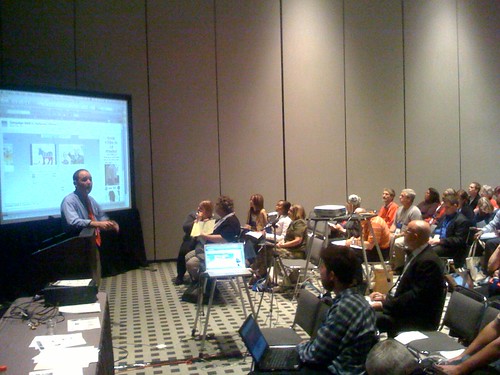 This is my third year of attendance at the NCSS annual conference and I was quite happy to have the opportunity to present with my good friend and colleague, Chuck Taft. Our presentation was titled, "21st Century Tools in the Social Studies Classroom" and it is archived and posted online here (a shout out goes to Chuck for his excellent work on building out this resource). Our goal was to build a 60 minute presentation in which we would share as many practical lessons and projects with the participants. We shared a historical simulation of the Lewis and Clark expedition, our Washington DC Travelogue, interactive campaign 2008 cartoon timelines, virtual press conferences with George Washington, and many other samples that are posted at the example page of our presentation website. Chuck and I were pleased that we had so many people attend our session, but honestly, I think the experience of collaborating with one another during the construction of this presentation was the real value to each of us professionally. A highlight of the presentation itself for me was the skype conversation with our student radio show team members, Natalie and Annie. Natalie and Annie did a wonderful job of giving a project overview and relaying their enthusiasm for the Gator Radio Experience to our session participants.
This is my third year of attendance at the NCSS annual conference and I was quite happy to have the opportunity to present with my good friend and colleague, Chuck Taft. Our presentation was titled, "21st Century Tools in the Social Studies Classroom" and it is archived and posted online here (a shout out goes to Chuck for his excellent work on building out this resource). Our goal was to build a 60 minute presentation in which we would share as many practical lessons and projects with the participants. We shared a historical simulation of the Lewis and Clark expedition, our Washington DC Travelogue, interactive campaign 2008 cartoon timelines, virtual press conferences with George Washington, and many other samples that are posted at the example page of our presentation website. Chuck and I were pleased that we had so many people attend our session, but honestly, I think the experience of collaborating with one another during the construction of this presentation was the real value to each of us professionally. A highlight of the presentation itself for me was the skype conversation with our student radio show team members, Natalie and Annie. Natalie and Annie did a wonderful job of giving a project overview and relaying their enthusiasm for the Gator Radio Experience to our session participants.Chuck and I really tried to present in a way that involved as many participants inside and outside of the physical space as possible. We created a back channel chatroom space for remote and physical participants to use to interact with each other. The presentation was ustreamed out on the Internet and we had several folks listen in remotely to contribute content (thanks, Pipes!!) The back channel chat was really interesting and is something that I think has real value for use in presentations like this going forward. It was great having everyone in the chat interacting with one another, dropping links, answering questions, etc. The back channel leveraged the collective knowledge of all of the session participants (remote and physical alike) in a way that simply is not possible using traditional methods. Click here to view the chat transcript from our session.
Props to the folks at NCSS, the Houston Convention Center, and the good folks at ABC-CLIO for providing a highly robust wireless Internet connection at the conference this year.
Thanks to everyone who participated and contributed to our presentation yesterday. Chuck and I appreciate it greatly!
Sunday, November 16, 2008
Vanessa Van Petten to Join Parents as Partners on Monday, November 17th
Vanessa will be talking with us about teens and social networking. Join in the conversation live over at Edtechtalk.com/live.
To learn a bit more abot Vanessa, view one of her clips below:
Thursday, November 13, 2008
Lesson Plan: Building collaborative wisdom through the use of a moodle forum
This was all done in roughly 45 minutes and here is what I observed (keep in mind that this really was the first time that the students ever used moodle).
1. ALL students contributed to the discussion for the entire time period. They were engaged in a way that is not possible in a traditional classroom discussion where one learner has the floor at a time.
2. A student or two jumped right on facebook when we started. I provided a re-direct and they closed out of facebook and worked on the discussion at hand without further distraction.
3. We had one problem with the lesson and that was time. When the class period came to an end, all of the students were quite busy contributing to the forum. They seemed to have lost track of time. What a nice problem to have!
While the activity went extraordinarily well, the next time we do something like this I think I'd consider modifying the follow up activity. The students had a follow up homework assignment that essentially required them to reflect upon their experience in class that day. Students were told to complete this in a word processor and then print it off and turn it in the next day. I'm thinking that they could've done this via a moodle web form assignment. At a minimum I believe this would've streamlined the process for turning in the follow up assignment to Christina.
Props to Christina for taking the risk with this project as we are both very new to moodle and of course this activity certainly could've flopped on us. But it didn't flop, and in fact it was quite successful and now gives us a broader base of experience from which we can build more powerful learning experiences in the future.
Below are a series of screenshots that show what the assignment looked like in moodle (click the photos for a better view of each):
Screenshot #1:

Screenshot #2:

Screenshot #3:
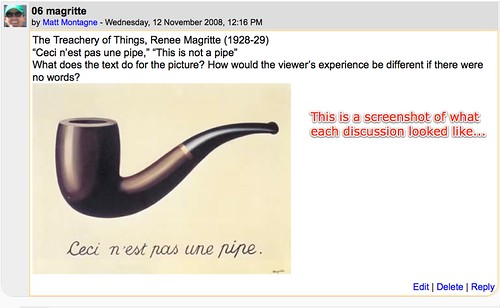
Screenshot #4:
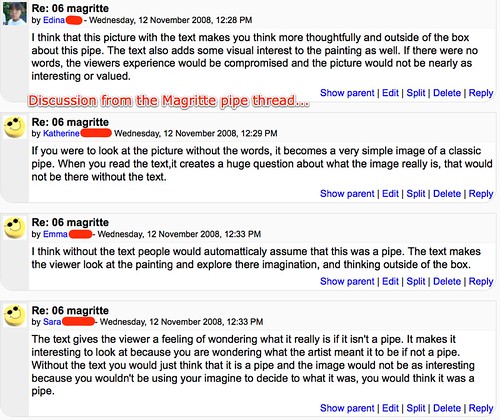
Wednesday, November 12, 2008
Interview with Tyrone Brown

Note to edtech folks: This is a recording from our 8th grade trip to Washington DC.
I had the good fortune to interview our tour bus driver from last spring's Washington DC trip, Tyrone Brown. We recorded this conversation while we were at Mt. Vernon. As you'll see from the interview, Ty is an exceptional man. The kids and adults who have the opportunity to be on Ty's bus are quite privileged. I hope you enjoy this conversation.
Direct Link to audio file
Tuesday, November 11, 2008
This is why students should post their content online...
The content that our students create and publish online has value. It means something and makes a difference. Enjoy:
Chuck Taft and the American History Rules Channel on YouTube
Thursday, November 06, 2008
The Impact of Election Technology on K12
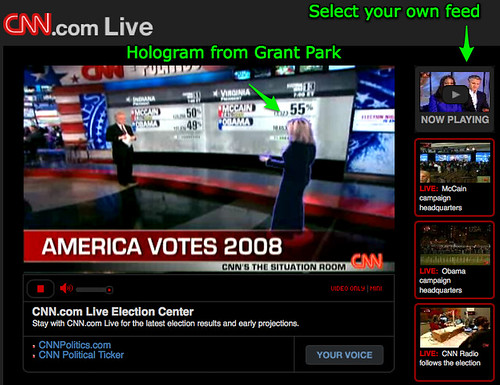 I was simply blown away by the different media technologies, some new and some older, that I interacted with on election day this past Tuesday. As someone who does not own a traditional television, I'm always searching out ways to find what I'm missing through TV on the Internet. At school on Tuesday morning I worked with Mary Jean Conlon, our super librarian at Castilleja, to get the CNN online coverage up and running in the library so students and teachers would be able to check out the coverage. After school was over, I tuned into this same online coverage on my laptop in my office. A few minutes after I began watching, CNN used hologram technology to bring a Grant Park reporter into the studio virtually (see screenshot). As an edtech nerd, the first thing that came into my mind was, "Wait until skype offers this feature!" In all seriousness, think of the implications on K12 education this technology might have?? Hey, two way skype video as a tool to bring experts from around the world into our classrooms makes for some powerful learning, but wait until we can hologram folks into our classroom!! Think of the possibilities!
I was simply blown away by the different media technologies, some new and some older, that I interacted with on election day this past Tuesday. As someone who does not own a traditional television, I'm always searching out ways to find what I'm missing through TV on the Internet. At school on Tuesday morning I worked with Mary Jean Conlon, our super librarian at Castilleja, to get the CNN online coverage up and running in the library so students and teachers would be able to check out the coverage. After school was over, I tuned into this same online coverage on my laptop in my office. A few minutes after I began watching, CNN used hologram technology to bring a Grant Park reporter into the studio virtually (see screenshot). As an edtech nerd, the first thing that came into my mind was, "Wait until skype offers this feature!" In all seriousness, think of the implications on K12 education this technology might have?? Hey, two way skype video as a tool to bring experts from around the world into our classrooms makes for some powerful learning, but wait until we can hologram folks into our classroom!! Think of the possibilities!I also really enjoyed CNN's multiple streams in their online coverage. I loved having the option to toggle between different feeds...it just seemed to add to the excitement in a way that static/traditional TV can't do.
The other media avenue that I fully enjoyed participating in was Twitter. I was completely glued to the Twitterstream...I follow people from all over the world and it was so interesting to get this first person, "boots on the ground" perspective that simply is not possible through the traditional television media. I absolutely loved the social nature of the experience, with twitterpals from all over the place sharing their take on the historic day. Again, the edtech geek in me thought about the possibilities associated with this form of media in the classroom. Twitter is a fantastic platform for building a network and for "making friends all over the world," which is something that Alan November thinks we should be teaching our kids to do (and I happen to agree with him). Once you have a "boots on the ground" network of people all across the globe, the possibilities for authentic learning becomes nearly limitless.
Saturday, October 25, 2008
The Gator Radio Experience - student radio show goes live this Wednesday, October 29th at 8:00 pm pacific
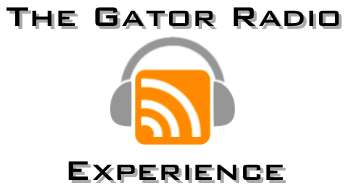 I'm pretty excited about this project that I've been working on with a small team of students at my new school here in Palo Alto, California. The idea is to have the students start and run a live, regular radio show from scratch. Our first show is scheduled for this coming Wednesday, October 29th at 8:00 PM Pacific. You'll be able to listen in to the audio stream on the Gator Radio Experience blog or at the Gator Radio Experience Ustream channel. The Ustream channel will have a live, interactive chat room component as well, but you'll need a password to join in (email/DM me if you'd like the password).
I'm pretty excited about this project that I've been working on with a small team of students at my new school here in Palo Alto, California. The idea is to have the students start and run a live, regular radio show from scratch. Our first show is scheduled for this coming Wednesday, October 29th at 8:00 PM Pacific. You'll be able to listen in to the audio stream on the Gator Radio Experience blog or at the Gator Radio Experience Ustream channel. The Ustream channel will have a live, interactive chat room component as well, but you'll need a password to join in (email/DM me if you'd like the password).This Wednesday's show will feature a little show overview, some Campaign 2008 conversation, a music set with some Creative Commons licensed music, and perhaps an interview with a special guest.
The students are pretty excited about this project and I'm thinking it will be a very positive experience for them. Please drop us a note at the Gator Radio Experience blog and let us know what you think about the show!
Friday, October 24, 2008
Yet Another Google Docs Success Story!
 One of the things I enjoy most about my job as an instructional technology coordinator is working alongside teachers to dream up creative, out-of-the-box projects for our students. I really enjoy the process of brainstorming ideas, implementing the project in the classroom, and then sitting back to see what unfolds. Sometimes, though, technology coordinators have to do the little things to help out around the school. This was the case for me when I was recently asked by the 9th grade class to help them with a system to facilitate the annual Halloween Cupcake Sale. They wanted a program that would allow them to collect information about who the cupcake was purchased for, what grade level that individual was in, and the name of the person purchasing the cupcake. The program also needed to be able to eventually print labels to go along with each cupcake, sort orders by grade level, and help the 9th graders figure out if there were any students who did not receive a cupcake. Last year they used a filemaker pro solution written by an employee who was no longer here, so I suggested that we develop a google form to collect the data. And because the data automatically populates to a spreadsheet, we could do some type of mail merge with a word processing program and print-out the cupcake information on avery labels. Today we battle tested this process during our morning break time. We had two students taking orders via the google doc form and a few students taking money. I gotta say that the process worked incredibly well and the girls did great managing the sale.
One of the things I enjoy most about my job as an instructional technology coordinator is working alongside teachers to dream up creative, out-of-the-box projects for our students. I really enjoy the process of brainstorming ideas, implementing the project in the classroom, and then sitting back to see what unfolds. Sometimes, though, technology coordinators have to do the little things to help out around the school. This was the case for me when I was recently asked by the 9th grade class to help them with a system to facilitate the annual Halloween Cupcake Sale. They wanted a program that would allow them to collect information about who the cupcake was purchased for, what grade level that individual was in, and the name of the person purchasing the cupcake. The program also needed to be able to eventually print labels to go along with each cupcake, sort orders by grade level, and help the 9th graders figure out if there were any students who did not receive a cupcake. Last year they used a filemaker pro solution written by an employee who was no longer here, so I suggested that we develop a google form to collect the data. And because the data automatically populates to a spreadsheet, we could do some type of mail merge with a word processing program and print-out the cupcake information on avery labels. Today we battle tested this process during our morning break time. We had two students taking orders via the google doc form and a few students taking money. I gotta say that the process worked incredibly well and the girls did great managing the sale.I suppose the most challenging thing on my end was entering all of the student and faculty/staff names in the form as options in a drop down list. Unfortunately the school roster that I received for our business office was alpha ordered by grade level, which meant that the names in the drop down list weren't alpha ordered across grade levels. This presented a few challenges to the girls as they entered sale information into the form. Finally, one other thing that I learned is that the forms can select at least 429 options in the drop down list (I was a little worried that there would be a limit on the number of options).
To borrow a phrase from Lee Lefeever at the end of his awesome Google Docs Commoncraft Video, "Google Docs Rocks!"
Monday, October 20, 2008
Gene Yang Recording: Re-post
Direct Link to audio file